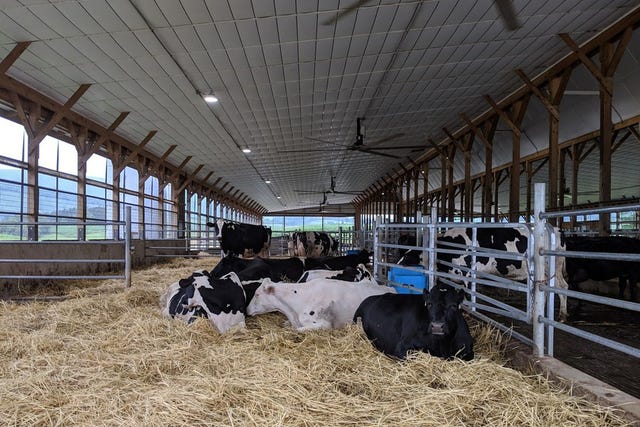Brad Heins, DVM, MFAM, Clinical Assistant Professor, Beef Production Medicine, 706-542-4312/bheins@uga.edu
Emmanuel Rollin, DVM, MFAM, Clinical Associate Professor, Dairy Production Medicine, 706-202-7821/Emmanuel@uga.edu
Department of Population Health, College of Veterinary Medicine, University of Georgia, Athens GA

With the significant demands placed on cows prior to calving and the onset of lactation, it is vital that the dairy manager is able to recognize individual animals and provide appropriate management changes or medical therapy to minimize the risk of lost production or premature culling of the individual animal. For many herds, great importance is placed on the individual genetics of the animal and ensuring that the cows being milked have high potential for milk production. While genetic potential is important, producers should remember that the environment of the cow, including nutrition, housing, and infection risk also contribute to the profit of the farm in the form of increased milk production and should be carefully managed.
The primary diseases that affect dairy cattle during the transition period are hypocalcemia (milk fever), ketosis, metritis (uterine infections), retained placenta (RP), displaced abomasum (DA), mastitis, and digestive upsets. It is extremely important for producers to be able to accurately recognize and diagnose these problems early in the course of disease and to apply appropriate treatments. Lactation number has a significant impact on the risk of disease with first lactation animals experiencing greater issues with dystocia and metritis and mature animals suffering primarily from metabolic derangements such as ketosis and milk fever. Ideally, separate groups would be provided for first lactation and mature animals both before and after calving to allow more individualized attention, better group environment, and different ration formulation; however that is wholly dependent of facility design, herd size, and management preferences.
A variety of methods are utilized by herds to identify and treat these health problems and each herd will have a preferred approach that varies based upon differences in available labor and facilities, number of cows going through transition, the ability of the labor to recognize problems, and the risk tolerance of the individual producer. Two primary approaches to identifying individual cows with transition problems include a prompted assessment program and a systematic monitoring and treatment approach. There is not one perfect method that will work for all herds, but rather, each farm’s management team should consider the benefits and pitfalls of each approach while also honestly assessing their own ability to manage each system. The keys to success are consistent and accurate detection of problems, timely application of treatment, and accurate recording of these events for further analysis of trends or changes in disease incidence.
The utilization of a prompted monitoring system such as pedometers or rumination monitors may be the easiest to implement as it reduces labor needs and may allow for timely intervention in some cattle populations, but these programs also may serve to limit the ability of farm staff to observe and recognize those animals with subclinical disease and moderate production parameters. One of the most obvious, and perhaps simplest, monitoring tool is a daily visual screening of all fresh animals. Cows that appear to have an excellent appetite, full rumen, and appear bright and aware of surroundings are probably transitioning well. Those animals which appear to be depressed, off feed, have dry noses, increased respiration, lameness, or dull eyes should be examined more closely. The measurement of daily milk production of the individual animal is also commonly used on herds to allow identification of animals for further analysis. Noticing rapid changes or failure to increase production will allow identification of animals which may need more individual attention to diagnose and treat ongoing disease processes. One should recognize that individual milk production may vary by as much as 9-10 lbs per day and while this may or may not indicate disease occurrence, it should be considered when determining a cut-point for a drop in daily milk yield.
Implementation of a systematic approach where all fresh cows are examined on a regular basis, may be a greater strain on the available labor and facilities, but would provide a more accurate knowledge of the number of animals having transition problems and where those problems may originate. While the specifics may vary between farms, the basic approach includes a daily evaluation of each transition animal (primarily during the first 10-14 DIM) including visual observation, rectal temperature, identification of early mastitis cases, and evidence of diarrhea, constipation, or other digestive upset. Trans-rectal palpation for the presence of uterine disease can be performed every second or third day or when prompted by an elevated rectal temperature or evidence of vaginal discharge. Special attention should be paid to high-risk cows including those with RP, twins, dystocia, high BCS scores (>4 at calving), milk fever, and known ketosis; however, this does not mean that low risk cows do not suffer from transition issues and should be ignored. Despite which program is used to monitor cattle on an individual basis, without the development of a complementary medical therapy plan for each type of disease, herd production will continue to suffer from disease incidence. Your regular herd veterinarian should be utilized to provide training for herdsmen to help them identify disease and to help determine appropriate medical therapy in order to achieve excellent results in a timely manner.
Elevated rectal temperature can be an effective tool and is utilized primarily as an indicator of uterine disease (metritis), mastitis, or pneumonia. The generally accepted reference range for cattle is 100.5-102.5°F (38-39°C), and the majority of animals with a concurrent infection will fall above this range and require treatment. The time of day should also be considered when temping cows as those suffering from heat stress may experience elevated rectal temperatures greater than 105°F well into the afternoon, even as ambient temperature begins to subside. Internal temperatures may also begin to rise following eating as the cow begins to digest feeds and metabolize energy and protein molecules. Ideally performed in the early morning hours when the effects of ambient temperature and feed intake and metabolism are minimal, it is important to be consistent with the method of measurement, the cut-off points for indication of further analysis or treatment, and possible reasons for a rise in temperature. Since it is not a true inflammatory process, fever may not be present with simple, uncomplicated metabolic derangements such as hypocalcemia, ketosis, or displaced abomasum. Conversely, the presence of an elevated temperature should not rule out a metabolic issue as animals experiencing immune insult often simultaneously suffer from negative energy balance. Additionally, placing a thermometer in an air-filled rectum following palpation or incomplete insertion will give an artificially low recording. For this reason, it is important not to limit fresh cow exams to simple “temp and treat” protocols that may not allow identification of all transitional issues.
Following the general observation and taking of rectal temperature should be a more hands-on physical exam. A physical exam sheet for each animal may be created or the individual responsible for examining sick animals may ask themselves multiple questions:
- General Health: Does the animal look painful (elbows out, scooch test, arched spine, grinding teeth) or depressed (dull eyes or unaware of her surroundings)? Does her skin feel turgid (stiff) or does she appear dehydrated in other ways? How is her manure consistency? Is it softer, more compacted, or does it have a different color or odor than other cows?
- Lameness: Is she lame when walking or standing? Is equal pressure put on all four limbs or does she favor one or more?
- Gastrointestinal System: Can you smell ketones on her breath? Does her rumen appear full and does it have 2-3 contractions a minute? Is it hypermotile (>5 contractions per minute)? Does she have an abomasal ping on either her right or left side?
- Cardiovascular/Respiratory System: How does her heart sound? Is the beat fast, slow, irregular, or difficult to hear? Are her lungs clear on both sides of her body or does it sound like she is having difficulty taking deeper breaths? Does her skin feel like there is air beneath it or crackle like bubble wrap?
- Udder Health: Is one or more of her quarters swollen or warm indicating the presence of mastitis? Does she paddle positive to a California Mastitis Test (CMT) or have clots or flakes in her fore-strippings? Using an appropriate ketosis test, does her urine, milk, or blood indicate the presence of an elevated level of ketones?
- Reproductive Health: Is there any evidence of vulvar discharge, including blood, pus or mucus? Is there significant trauma to the uterine walls? Does her uterus feel like it has begun to involute following calving or is an abnormal amount of fluid present? Can you express any of that fluid with gentle manipulation of the reproductive tract?
All of these questions, in some form, should be part of a basic physical exam of a cow suspected to be suffering from transitional disease. It is important to be thorough, starting and ending in the same way each time in order to avoid costly errors such as a missed diagnosis.
Ideally, the cursory physical examination will allow the producer to arrive at a decision for intervention and treatment. This decision should be made with appropriate information including input costs, prognosis for return to a successful lactation, treatment costs, cull value, and replacement animal value. Possible scenarios for this intervention include: 1) sale for cull value or euthanasia if the situation offers low likelihood for successful lactation, 2) treatment with antibiotics and observation of appropriate withholding times, 3) surgery if the situation warrants, 4) supportive treatment including glucose, dextrose, anti-inflammatory drugs (fluxinin meglumine), calcium, drenches or other supplements, or 5) waiting to see if she improves or worsens over time.
As much as it is important to identify those animals which are experiencing transition disease, it is vital to consider the time budget of the lactation group when examining transition cows. If cows are to be locked in headlocks for examination, fresh feed should be made available and the fresh cow examinations and treatments completed as efficiently as possible. Management rail systems are nice in that small groups may be selected for further analysis, but there is a risk in keeping those animals away from water and fresh feed and accidentally releasing them to the wrong group. Excessive time away from feed and water and reduced lying behavior may negatively impact the production of those cows transitioning successfully and should be avoided whenever possible. The total time period in lock-up or away from feed and bedding should be no greater than 1.5 hours, including the time spent in the parlor for the morning milking. For this reason, it is vital to be efficient, but thorough and to ensure all employees are trained in the same manner.
While the methods of examining fresh cows are different on each farm, it remains important to give each animal the best opportunity for a successful lactation. By having standard protocols and continuous employee training, it allows for consistent application of diagnostic and therapeutic procedures to occur. It should go without saying that in addition to the hands-on approach, some form of record keeping should be utilized on a regular basis to record the incidence of disease and what treatments (and the subsequent withhold times) are needed. The utilization of records and group monitoring tools will be discussed in a future article to allow identification and manipulation of a herd problem which should be addressed in order to minimize the effect to subsequent groups.
For further information regarding how to evaluate your fresh cows, please consult with your animal health team including your veterinarian and nutritionist.
